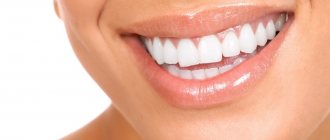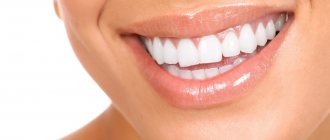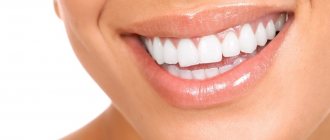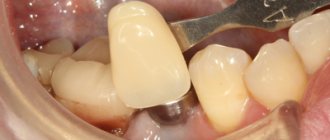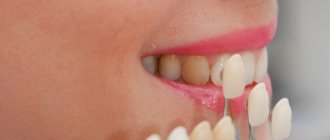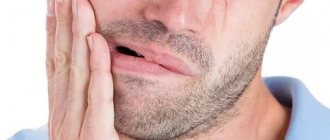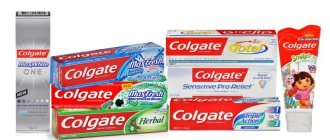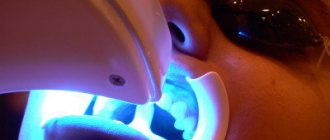If you want to improve the appearance of your smile, if you don’t like something about it, but you cannot accurately and correctly formulate what exactly, if you want to talk with your dentist about the aesthetics of your smile in the same language, then the following note is just right for you.
Nature (or God... depending on your views on life) has made us different. And our originality and uniqueness have its own charm. But what to do when this uniqueness goes too far beyond our ideas of beauty? How to formulate your claims to nature (and perhaps to the previous intervention of dentists)? To assess the aesthetic component of our face, lips, teeth - everything that gives rise to a beautiful, harmonious smile, it turns out that there are many parameters. This is what dentists use (at least should use) when planning changes in your appearance. Since there are very, very many different nuances, and I do not have the task of making each of you an expert in the field of aesthetic dentistry , we will focus on the ten simplest and most important.
Parallelism of horizontal landmarks.
One of the most important signs of a harmonious smile is the parallelism of imaginary lines: the interpupillary line (in the picture there is a blue line connecting the right and left pupil of the eye) and the lip line (in the picture there is a red line drawn between the corners of the mouth).
Both of these lines should also be parallel to the lines connecting the edges of the central incisors (green) and the incisal cusps of the canines (blue)
Gum level.
A smile looks attractive and more aesthetically pleasing , in which the line connecting the necks of the teeth (shown in dotted lines) repeats the line of the upper lip, and the level of gum exposed when smiling is symmetrical on the right and left. At the same time, with a maximally open smile, only the gum “triangles” between the teeth and a small strip of gum above them (no more than 2-3 mm wide) should be noticeable.
Thus, the gums around the upper teeth, upper and lower lips form a kind of frame for your smile. If the “picture” is not visible behind the frame, then such a smile will not look attractive.
Excessive visualization of the gums (the so-called “gummy smile”) is most often eliminated with the help of surgery, orthodontic treatment, as well as cosmetic interventions (for example, Botox injections into the upper lip, upper lip augmentation, etc.).
Method 1. Express processing
Go to the "Automatic retouching"
.
Here are ready-made styles for facial enhancement. In addition to general processing options, there are presets for specific tasks, for example, smoothing the skin, eliminating shine, giving expressiveness to the look
.
The “Teeth Whitening” and “Perfect Smile” styles are suitable for us.
. The first one treats only the teeth, and the second one additionally makes the lips brighter and more expressive.
“Teeth whitening” will instantly remove yellow discoloration
Apply the selected preset, and the photo will instantly transform! Try it now:
Works great on Windows 10, 8, 7, Vista, XP
Vertical symmetry and midline.
A line passing through the center of the face should pass exactly between the central incisors of the upper jaw. The discrepancy between these lines causes a feeling of disharmony even with a quick glance at your smile from the outside. In this case, it is not at all necessary that it also passes between the central lower incisors. Firstly, a complete match is rarely found, and secondly, this in no way affects the aesthetic perception of your smile when viewed from the outside.
"Golden proportion".
The principle of the golden proportion in relation to a smile in aesthetic dentistry is that when looking at it from the front strictly in the center, the ratio of the apparent width of the front teeth should be approximately the following - 0.6 (width of the canine): 1 (width of the lateral incisor): 1.6 (width of the central incisor ).
As can be seen in the photo, the width of the visible part of the remaining teeth (4s, 5s) should consistently decrease, creating a sense of perspective.
Professional whitening
If you look at the photo showing teeth before and after whitening in a dental clinic, it becomes clear that going to a specialist gives a guaranteed result. A professional enamel lightening procedure involves influencing dentin with special active substances-agents, due to which teeth become lighter by up to 12 tones.
Professional teeth whitening: before and after photos
The teeth whitening procedure at the dentist most often occurs in several stages:
- Application of special professional bleaches.
- Enhancing the activity of the applied composition by heating the tooth surface with a laser or a special lamp.
- Washing the reagent with water.
- Coating the dentition with a protective fluoride-containing varnish.
The duration of professional whitening ranges from 30 minutes to 2 hours, that is, the effect will be achieved in just one session with the dentist.
Proportions of the tooth.
The central incisors of the upper jaw always attract special attention, because... best visible when talking and smiling. Therefore, it is very important that their proportions are correct. The most harmonious looking teeth are those with a ratio of tooth width to length of approximately 0.7-0.8: 1
However, at different ages this ratio may change. Due to the physiological wear of teeth in older age, this ratio tends to be 1:1. Therefore, if you want to “rejuvenate” your smile, you usually need to increase the length of the tooth.
Lightening enamel at home
At home, special pencils, strips, and pastes are used to whiten teeth, which are sold in pharmacies and regular stores. Some of them turn out to be quite effective. If you use such products for a long time, you can get rid of yellow plaque, and sometimes lighten your teeth a couple of shades.
For example, with the help of whitening strips you can make your smile snow-white in just 2-3 weeks , the effect will last for 3-4 months. A dental pencil is an analogue of a lightening gel. Its advantage is the convenience of applying the active substance to problem areas. Whitening paste will be effective only if a person has chosen the right toothbrush and brushes his teeth for a long time.
Products available to the average consumer should be used with caution. Teeth whitening at home often leads to increased sensitivity of the gums.
You shouldn’t expect quick results from such manipulations; in one day you can whiten the surface of a tooth on your own only with the help of preparations whose components do not clean, but paint the enamel white.
The most popular and safest way to whiten teeth at home is to use baking soda. You just need to add sodium bicarbonate to toothpaste, apply it to a regular toothbrush and clean the enamel.
Ash and activated carbon remove plaque quite well in hard-to-reach places. But with the help of these products you can achieve a minimal whitening effect: after several months of regular use, the enamel will become lighter by just a couple of tones.
Interincisal angles.
Interincisal angles are the spaces between the cutting edges of the anterior group of teeth.
With the harmonious construction of teeth, these angles should gradually increase from the center to the periphery: from a small closed angle between the central incisors, to a more direct and even open angle between the 2nd and 3rd teeth.
Tooth wear leads to a decrease or complete absence of interincisal angles, which makes the patient look older when he smiles.
At the same time, “female” teeth are characterized by rounded corners of the incisors, while “male” teeth are characterized by straighter ones.
Zenith of the gingival contour.
The zenith of the gum is its most concave part around the neck of the tooth (indicated by dots in the photo).
The level of zeniths near different teeth in the smile zone should be at different levels. For the central incisors and canines - approximately at the same level (or slightly higher for the canines), for the lateral incisors - slightly lower than both (as shown by the lines in the photo). At the same time, it is equally important that the zeniths on symmetrical teeth are at the same level. This is especially important to consider if this area becomes noticeable when smiling. When even with the most open smile the gums are not exposed, then there is no serious need to set the zeniths perfectly symmetrically.
In this case, attention is drawn to the too low zenith level on tooth 12; it is significantly lower than the symmetrical tooth 22. There is also a slight difference in the position of the zeniths on the central incisors (teeth 11 and 21). As a result of treatment, these shortcomings were eliminated, as can be seen in the first photo.
Possible side effects and contraindications
Unlike laser whitening, the use of cold light does not cause strong heating of tooth tissue and has fewer side effects. But we still cannot exclude the possibility of their occurrence:
- Increased sensitivity of tooth enamel for several days after the whitening procedure.
- The occurrence of allergic reactions to the components of the gel.
- Irritation of the mucous membranes of the mouth as a result of accidental contact with active substances.
In addition, the photobleaching technique, like any other medical procedure, has some contraindications:
- Age up to 18 years.
- The entire period of pregnancy and lactation.
- Intolerance to any substances included in the whitening system.
- Increased sensitivity of tooth enamel.
- Untreated carious cavities, chips and cracks on the enamel surface.
- Excessive abrasion of tooth enamel in congenital pathologies.
Position of cutting edges.
The cutting edges of the central group of teeth are also located at different levels. For the central incisors and canines - approximately at the same level, for the lateral incisors - slightly higher (as marked by lines in the photo).
Again, due to the abrasion of teeth with age, the cutting edges of the teeth become at the same level, the line connecting them takes on a straight rather than convex appearance, and sometimes (with increased pathological abrasion) even concave. Therefore, to make a smile more “youthful,” you need to return the relationship of the cutting edges to a harmonious one.
It can also be noted that the dominance of the central incisors over the lateral incisors and canines also gives the smile a more youthful appearance.
The dominance of the canines, their sharp, prominent cutting cusps, make the smile more aggressive. This effect is based on the fact that in nature, long, sharp, well-developed fangs are characteristic of predators, whose entire philosophy of existence is based on aggression towards their prey.
What is laser teeth whitening –
There are several different types of professional whitening. For example, the “Zoom-4” and “Beyond Polus” techniques refer to the so-called “photobleaching”. This is because they involve the use of a special whitening lamp that emits different wavelengths of light at the same time (for example, in the range of 400 to 500 nm). Such lamps make it possible to increase the rate of decomposition of hydrogen peroxide into atomic oxygen.
But there is also so-called laser teeth whitening - with systems such as Picasso (AMD LASERS), Smartbleach®, etc. This technique also requires the presence of a light source, which is a laser beam of one strictly defined wavelength (for example, 810 nm). The disadvantage of this technology is a slightly greater risk of overheating of dental tissues, which can lead to the development of aseptic pulpitis, as well as the high cost of the procedure.
For example, in different dental clinics for photo and laser teeth whitening, the price usually varies on average from 15,000 to 30,000 rubles (the minimum price is from 10,000 rubles), and this does not include the cost of maintenance therapy that you will have to carry out at home.
Why are whitening lamps and lasers needed? For many years, there have been debates in dentistry - whether activation by light really speeds up and improves the process of teeth whitening... or is it just marketing that allows these systems to give a more professional look, which also allows them to be justified in the eyes patients their very high price. Independent clinical studies by different authors (Hein 2003; CRA 2003; Kugel 2006, etc.) showed that the whitening results were the same - both in cases where only the whitening gel was used, and in cases when the same gel used in conjunction with a light source.
Professional whitening without light sources –
There are also professional chemical whitening techniques that do not require any light sources. An example is the Opalescence Boost PF whitening system based on a whitening gel with 40% hydrogen peroxide. This system, produced by ULTRADENT (USA), is no less effective than photo- and laser whitening methods, and due to the absence of the need to use an expensive light lamp, the cost of the procedure will be significantly lower.
Interdental gingival papillae.
The gingival papilla is the part of the gum that fills the interdental space (marked with lines in the photo).
The location and appearance of the papillae is determined by the underlying bone, which has exactly the same contour. In the most optimal option, the tops of the gingival papillae are located as in the photo (marked with dots) - between the central incisors the gingival papilla is longest, and gradually its length decreases towards the periphery. Moreover, they should all have a healthy appearance - a triangular shape with a sharp apex, pink color, no swelling.
With various periodontal diseases, as well as with improperly performed restorations, the gingival papilla may become inflamed, acquiring a darker (or even bluish) color, losing its pointed shape, or may even disappear completely. At the same time, unaesthetic black spaces form between the teeth.
This is what the main, but still far from complete, list of parameters that need to be assessed and taken into account when planning and creating an ideal smile looks like. aesthetic dentistry does . Now you can evaluate for yourself how close your smile is to ideal. And I hope that this note will help you better understand what exactly you would like to change and improve. After all, this will greatly facilitate mutual understanding between you and your dentist.
PS See the photographs of clinical cases of my patients presented in this note in detail in the photo gallery section of the site, where details about aesthetic dentistry and modern dental technologies for restoring an ideal smile.
Which Russian stars have veneers?
Veneers are thin overlays. Their goal is to mask visual defects on natural teeth. Stars with veneers have a beautiful smile and an attractive appearance. This makes them popular, memorable and creates a standard of beauty. Among the famous personalities are:
- Nastya Ivleeva is a famous blogger and TV presenter. She put on camouflage pads after she became famous. Nastya claims that a star must have a Hollywood smile, so she didn’t think twice before correcting her bite.
- Yegor Creed is a singer whose concert prices exceed several million. Egor had previously had straight teeth. Cosmetic pads made his smile snow-white and attractive. Thousands of women all over the world want to become Yegor's chosen one, and he acquires the status of an eligible groom.
- Yulia Nachalova also resorted to the help of veneers. Initially, Julia's front incisors were shorter than the rest of her teeth. This forced the girl to take advantage of modern dental opportunities.
- Olga Buzova, a TV presenter and pop diva, never complained about her teeth. They were fairly even, but not snow-white enough. Therefore, the star installed the records, and now her smile looks stunning, which allows the singer to gain millions of new fans every day.
- Alena Vodonaeva - few people can remember the crooked teeth of the former House-2 participant. Long-term correction of the bite and subsequent installation of veneers helped the girl achieve a highly aesthetic smile. Now she shines on the covers of magazines, showing off her incisors.
- Maria Gorban – the actress’s teeth were initially straight. However, the bottom line could not boast of this quality. Ceramic linings helped correct the situation.
